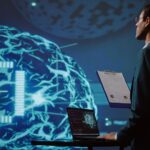As artificial intelligence (AI) advances rapidly, it is reshaping industries and transforming the job market. While AI offers substantial opportunities for increased productivity, innovation, and economic growth, it also presents challenges for employment, requiring adaptation from both individuals and organizations. This blog will dive into the opportunities AI brings, the potential challenges, and strategies to ensure a balanced future for workers.
Opportunities Created by AI
Enhanced Productivity and Efficiency
AI can streamline processes, enhance productivity, and minimize human error. Automation allows organizations to focus on innovation and high-value tasks, freeing employees from repetitive tasks. For instance, AI tools in data analysis allow companies to process information quickly and make better business decisions.
New Job Creation in Tech and Related Fields
AI is creating new jobs in data science, machine learning, AI development, and more. Roles such as AI ethicists, data scientists, and automation specialists are in high demand, with fields like natural language processing (NLP) and robotics growing rapidly.
Demand for Upskilled and Reskilled Workers
As AI transforms roles, employees are encouraged to learn new skills to remain relevant. Upskilling and reskilling programs offer employees a path to adapt to new requirements, reducing job displacement risks and preparing them for more complex roles.
Challenges Posed by AI in Employment
Job Displacement in Routine Roles
AI has the potential to displace workers in sectors that rely on routine tasks, such as manufacturing, logistics, and customer service. Workers in these fields may face challenges as roles shift towards automation, requiring new skills to stay employable.
Skill Gaps and Education Needs
The rapid development of AI calls for specific technical skills that are currently in short supply. Bridging this skill gap is essential, which will require significant investments in education and training programs.
Economic Inequality and Access Issues
AI adoption may increase economic inequality if lower-income workers, who are more susceptible to job displacement, lack access to reskilling opportunities. Addressing this challenge requires policies to ensure equitable access to training and new job opportunities.
Industries Most Affected by AI
Industries such as manufacturing, finance, healthcare, and retail are particularly impacted by AI. In manufacturing, robotics and automation are changing production lines. In finance, algorithms can manage portfolios and detect fraud. Healthcare is leveraging AI for diagnostics and treatment planning, while retail uses AI for inventory management, personalization, and customer insights.
Adapting to AI in the Workplace
Lifelong Learning and Reskilling
Encouraging a culture of lifelong learning will be key to navigating an AI-driven workplace. Employees should focus on both technical and soft skills like problem-solving, adaptability, and creativity, which are less likely to be automated.
Government and Corporate Support
Policies promoting workforce development, such as funding for reskilling programs and tax incentives for businesses that invest in training, can help mitigate the negative impacts of AI on employment.
Fostering Human-Centric AI
Designing AI systems that enhance human capabilities rather than replace them will be crucial. By fostering a collaborative approach, where humans and AI complement each other, companies can build sustainable work environments.
Real-World Applications of AI in Various Sectors
AI in Healthcare
AI is transforming healthcare with applications in diagnostics, predictive analytics, and patient care. Algorithms can detect diseases from medical imaging, while predictive models help manage patient treatment plans.
AI in Finance
In the finance sector, AI is used for fraud detection, risk assessment, and personalized financial planning. These innovations reduce costs and enhance accuracy but may replace certain financial services jobs.
AI in Customer Service and Retail
In retail, AI-driven recommendations and chatbots are enhancing customer experience. Machine learning helps retailers manage inventory, forecast demand, and tailor marketing efforts.
The Future of AI and Employment: A Balanced Approach
The future of AI and employment relies on a balanced approach where technology complements human efforts rather than replacing them. Embracing human-AI collaboration, fostering skills development, and implementing supportive policies will be critical. With the right balance, AI can be a driver of economic growth, innovation, and job creation.
Conclusion
The impact of AI on the job market is profound, offering opportunities for growth and efficiency while presenting challenges in terms of job displacement and skills gaps. By understanding the differences between job roles that can be automated and those that require human skills, businesses and governments can create pathways for workforce adaptation, ensuring AI benefits the entire economy.
By focusing on equitable access to education, reskilling opportunities, and supportive policies, we can shape a future where AI drives both economic success and workforce development.


